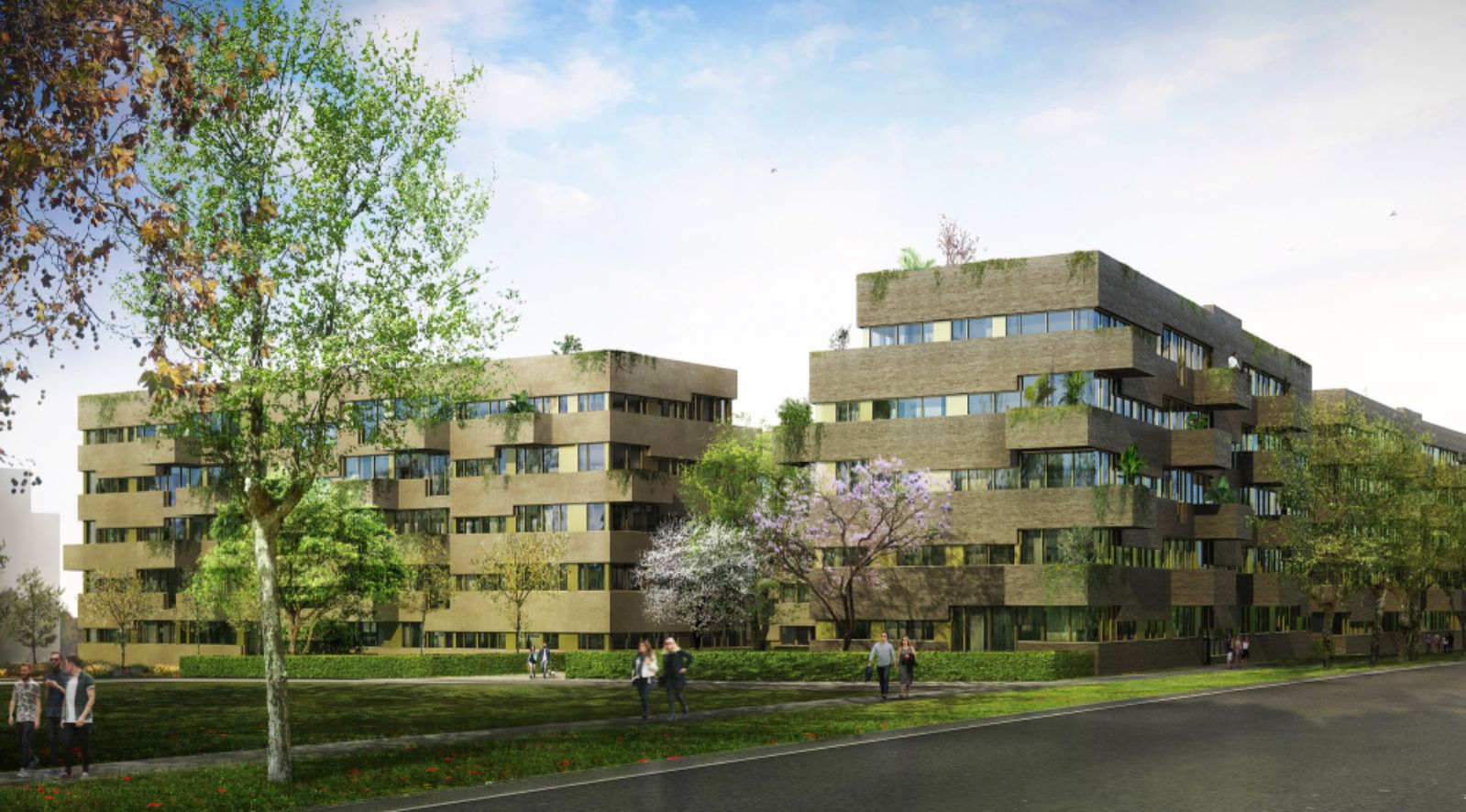A unified concept with variations over the 9 buildings:
The study that has been conducted for Plot 21 offers a means of highlighting the importance of finding simple means to create a dynamic and diversified architectural signature. Firstly, there is the idea of ‘noble’ facades in grey brick across the buildings that face the street. This homogeneity means that the plot harmonises with its immediate context and is in dialogue with the neighbouring buildings, which are similarly sober and have the same palette of colours.
Secondly, the idea of a ‘band’ embellished with balconies in staggered rows is easily adaptable to different typologies of apartments, depending on the buildings, guaranteeing a certain opulence without appearing repetitive. In this way each building is different, whilst engaging in a similar visual language to its neighbours, offering an overall sense of similarity. The coherent, unified appearance dictates the atmosphere of the wider neighbourhood.
Finally, the rhythm between the solid areas of the facades and the various openings enhances the sense of diversity. Embellished by gold metallic sections which harmonise with gold-anodised aluminium doorways and windows, the opaque spaces change appearance according to the orientation of the façades.
A partition, a unique graphic composition, brings a material musicality to the whole concept, whilst elegantly bringing life to the compact nature of the buildings. The idea of variations is easily imaginable thanks to the natural variations in depth between the buildings and their positioning, the bands and the openings that adapt in each case.
Guaranteed technical objectives:
For all the buildings, flexibility for the units is privileged thanks to an efficient construction system (cross walls with columns on the facades) and the grouping of zones (wet zones and cooking zones) and circulation cores in the central parts of the buildings. This principle favours an arrangement that is adapted to the needs of families as well as guaranteeing that a majority of the apartments will have a double orientation, depending on individual wishes. The living/sleeping division is clearly identified.
In-depth consideration has also been given to energy performance, in order to attain the objective of constructing passive buildings certified AAA according to Luxembourg regulations. To achieve that aim, several elements must be implemented:
-A high performance facade, notably the use of 24cm thick concrete with exterior insulation in mineral wool of 26cm.
-The choice of a brick facing for the façade, which improves thermal performance and enhances the low environmental impact of the building.
-High performance aluminium joinery with triple glazing, positioned on the outer edges of the concrete in order to minimise thermal bridges.
-A light filtering system and/or solar protection to help reduce heat intake.
-Thermal bridge breakers for the balconies.
-Enhanced insulation between heated and non-heated areas.
-Intensive planting on the rooftops with the eventual installation of thermic solar panels for heat regulation.
Spatial organisation dictated by strict principles:
A game rule is imposed which brings individuality to each building.
Firstly, the organisation on different levels, lightening the visual impact, with cut-out areas having a direct impact on the light entering each room, whilst guaranteeing privacy, vital for domestic life.
The heights are on average 1.65m, varying in dimensions according to the layout of the apartments and thanks to precise sectional work. Secondly, the dimensions of the balconies, which are positioned in order to divide up the double heights, vary between 4.50m long x 2.00m deep (extending the living rooms out onto the terrace), and 3.50m x 1.50m (off the bedrooms). Finally, there are opaque parts on the glazed walls, framing the structure of the apartments (in order to establish partitions).
Similarly, the ground floors offer dual aspect lobbies, lit by natural light, which are in constant dialogue with the street, the landscape and the internal areas of the block. Attention is also paid to the social relationships of the residents, by judicious organisation of communal areas on this level as well as recognising the importance of establishing spaces where people will naturally interact with each other. Source by Agence Beckmann-N’Thépé
- Location: Reimerwee, Luxembourg
- Architects: Agence Beckmann-N’Thépé, AZPML
- AZPML Project manager: Guillermo Fernandez-Abascal
- Architects: Manuel Eijo, Ivaylo Nachev
- Client: Société Nationale des Habitations à Bon Marché (Luxembourg)
- Urban developer: Fonds Kirchberg (Luxembourg)
- BNT Project manager: Laura Ros
- Architect: Amélie Rigaud
- Intern: Héléna Menon
- Surface area: 3 938 m2 (3 buildings)
- Year: May 2016
- Images: SBDA, Courtesy of Agence Beckmann-N’Thépé
